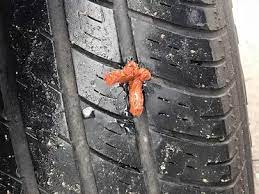In general, the more weight that is put on the tire and the larger the puncture is, the less time the plug will last. Plugs are temporary solutions, not permanent fixes. In some cases, plugs can make good as new tires.
Here’s what you should do if you’ve plugged your tire.
- Get a new tire as soon as possible. A plug is simply a temporary fix, and you’ll need to get your tire replaced to ensure safe driving going forward.
- Keep an eye out for signs that the plug is failing. If the air pressure in your tire drops or if it starts feeling like there’s not enough air in it, don’t risk driving more than you have to. Head straight back to the shop so they can properly diagnose what’s going on and either replace or repair the tire (or both).
- Don’t drive faster than 50 mph. Again, a plugged tire is just a temporary solution and shouldn’t be relied on for long periods of time; by driving slower, you’re making sure you minimize any damage that could occur if the plug fails while traveling at a high speed.
- Check the air pressure regularly. Plugs can leak over time, so make sure you keep an eye on that tire pressure gauge—especially if your plugged tire has been put through harsh conditions like heat or rain since being repaired.
And most importantly: don’t drive further than you have to! Since plugs are only meant as temporary fixes, it’s best practice to not take any unnecessary trips with them in place; this will help prevent potential damage while also conserving gas mileage by keeping your car running at its most efficient level.
How to tell when a plug isn’t going to be strong enough for your needs.
A plug is not a permanent solution. If you’re tire is constantly losing air pressure, vibrating, or has a bulge in the sidewall, you need to replace your tire. It’s also important to note that if the plugged tire is hot to the touch after driving on it for a while, the plug may be failing internally.
If any of these signs are present with your plugged tire, we wouldn’t recommend driving on it at all and suggest replacing it as soon as possible instead.
What could go wrong if you drive on a plugged tire for too long?
If you drive on a plugged tire for too long, you could wind up with an unsafe vehicle. It’s important to fix a damaged tire as soon as possible, so that it doesn’t become even more damaged. If you continue driving on a plugged tire for too long, it could potentially blow out or come out of the tire entirely.
Don’t drive on a plugged tire for longer than you have to, and always keep an eye out for signs that the plug is failing.
How long can you drive on a plugged tire?
You can probably continue to drive on it, but it’s not a good idea. Only use a plug until you get to a repair shop. If you’re far away from civilization, then drive slowly and carefully (at 30 mph or lower). Just make sure that the repair shop is able to put in a proper patch when you get there so that your tire will be in better shape than before.
How do I know if the plug is failing?
If you notice uneven wear or bulging on your tires, then the plug might be failing. Also, if you see treads separating from the tire body and bits of rubber coming off of your tire, then the plug has failed and needs to be repaired as soon as possible.


